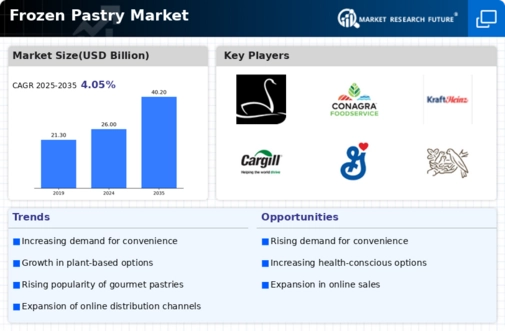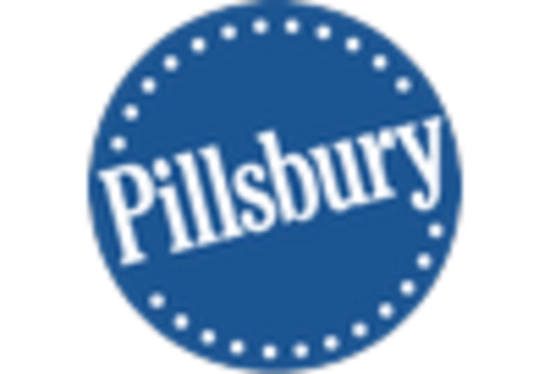E-commerce Growth
The rise of e-commerce has transformed the way consumers purchase food products, including those in the Frozen Pastry Market. Online shopping platforms provide convenience and accessibility, allowing consumers to explore a wide range of frozen pastry options from the comfort of their homes. Recent statistics indicate that online grocery sales are expected to reach a substantial percentage of total grocery sales in the coming years. This shift towards digital purchasing is likely to enhance the visibility and availability of frozen pastries, thereby driving sales. As more consumers embrace online shopping, the Frozen Pastry Market stands to benefit from increased distribution channels and the ability to reach a wider audience.
Health and Wellness Trends
The growing emphasis on health and wellness is significantly influencing the Frozen Pastry Market. Consumers are increasingly seeking products that align with their health goals, leading to a demand for pastries that are lower in calories, sugar, and unhealthy fats. This trend has prompted manufacturers to reformulate their products, incorporating healthier ingredients and transparent labeling. Market Research Future indicates that the health-conscious segment is expanding, with a notable percentage of consumers willing to pay a premium for healthier options. As the focus on nutrition continues to rise, the Frozen Pastry Market is likely to adapt by offering a diverse range of health-oriented pastries, catering to the evolving preferences of consumers.
Convenience and Time-Saving
The Frozen Pastry Market is experiencing a surge in demand due to the increasing need for convenience among consumers. Busy lifestyles have led to a preference for ready-to-eat and easy-to-prepare food options. Frozen pastries, which require minimal preparation time, cater to this demand effectively. According to recent data, the convenience food sector is projected to grow at a compound annual growth rate of approximately 4.5% over the next few years. This trend indicates that consumers are likely to continue seeking quick meal solutions, thereby driving the growth of the Frozen Pastry Market. As more individuals prioritize time-saving options, the market for frozen pastries is expected to expand, offering a variety of products that align with this consumer behavior.
Innovative Product Development
Innovation plays a crucial role in the Frozen Pastry Market, as manufacturers continuously seek to introduce new and exciting products. The introduction of unique flavors, textures, and health-oriented options has the potential to attract a broader consumer base. For instance, the rise of plant-based and gluten-free pastries reflects changing dietary preferences and the demand for inclusivity in food offerings. Market data suggests that the plant-based food sector is anticipated to grow significantly, which could positively impact the Frozen Pastry Market. By focusing on innovative product development, companies can differentiate themselves and capture the interest of health-conscious consumers, thus fostering growth in this competitive landscape.
Cultural and Culinary Diversity
Cultural and culinary diversity is becoming a prominent driver in the Frozen Pastry Market. As globalization continues to influence food preferences, consumers are increasingly interested in exploring international flavors and traditional pastries from various cultures. This trend has led to the introduction of a wide array of frozen pastries that reflect diverse culinary traditions. Market data suggests that ethnic foods are gaining popularity, with a significant portion of consumers expressing interest in trying new and exotic flavors. By embracing this diversity, the Frozen Pastry Market can tap into a growing consumer base eager for unique and authentic culinary experiences, thereby fostering market expansion.


















Leave a Comment